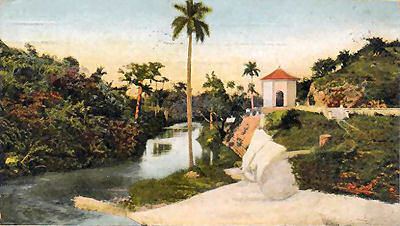 | ||
The Acueducto de Albear (Albear Aqueduct) is the name of a water supply system of the city of Havana, Cuba, built in the 19th century by Francisco de Albear.
Contents
Background
At the beginning of the 19th century, the city of Havana, Cuba, started to feel a severe shortage of drinking water. After having negotiated with several French engineers, in 1852, the Governor of Cuba José Gutiérrez de la Concha, decided to create a commission to propose solutions for the water supply of the city. The commission was to be chaired by Francisco de Albear, at that time colonel of the Corps of Engineers of the Spanish army and chairman of the Public Works Committee of Cuba. His main assistant was José Luis Casaseca, Director of the Institute of Chemical Investigations of Havana. The construction of a new water supply system was a necessity for the improvement of the sanitary conditions of the city. There had been severe outbreaks of cholera in 1850, 1856, 1865 and 1867-1870. The mortality due to dysentery and other waterborne diseases was also high.
The investigations carried out by De Albear’s team were extensive. He investigated various alternatives among which the use of the Luyanó, Martín Pérez, Guasabacoa, Marianao or Almendares rivers as well of the Cacahual or del Calvario springs, all of which he rejected for various reasons. He finally settled for the use of the del Vento springs, both due to the superior water quality and for the possibility of conveying the water by gravity, the source being located 41 m higher than the city. Chemical studies carried out by José Luis Casaseca lead to the conclusion that the water of the del Vento springs had to be isolated from the Almendares River, to prevent a deterioration of the water quality, which was of great concern, due to the tropical location of the island.
However, it was only in 1855, that a second commission, chaired also by Francisco de Albear, started extensive geological and hydrological field surveys, to ascertain that the springs had the capacity to cover the water requirements of the city. Finally, on November 25, 1855 De Albear was able to present his report to Governor José Gutiérrez de la Concha.
Copies of the report were sent to the Ministers of Interior (Ministro de Gobernación) and of Public Works (Ministro de Fomento) in Madrid. The "Royal Decree for the conveyance of the water of the Vento springs to Havana" was signed on October 5, 1858. To ensure the financing, the decree suspended for three years all payments from the revenue generated by the Fernando II acqueduct, imposed an annual fee of 45 pesos for each water faucet and authorized the governorship to raise another 500,000 pesos through taxes, if necessary.
On February 18, 1859, Governor Gutiérrez de la Concha created the Administration of the de Vento canal, Board of Directors
Main components of the project
Though called an aqueduct, the project presented by De Albear is complex water supply system, including the following components:
Technical features
The canal has an oval cross section, being 2,40 m deep and having a maximum width of 1,98 m. With a slope of 1:5000 it can convey a discharge of 1,67 m³/s (144.000 m³/day) at normal water levels. However, at higher water levels the capacity of the canal can be increased to 302.800 m³/day. It should be taken into account that, according to the standards in force at the time the canal was designed, the water requirement was of 500 l/day per inhabitant
Construction of the water supply system
In 1861, the construction started under the direction of Francisco de Albear. The progress was however extremely slow due to the scarcity of available funds and to the disturbances created by the Ten Years' War.
Work on the water distribution network started only in 1874 when Francisco de Albear made the first complete topographic survey of Havana and produced a 1:5000 plan of the city. Based on these surveys, he completed the design of the network and fixed the location of the water storage tanks.
In the meanwhile, the water supply of the city had worsened, as a result of the project’s construction delays. After the Peace of Zanjón was signed with the independentist rebels on February 10, 1878, the first part of the canal could finally be completed and, on June 23, 1878 the link of the De Vento Canal and the filters of the Fernando VII acqueduct could finally be inaugurated by Governor Arsenio Martínez-Campos Antón.
Completion of the project
Francisco de Albear, infected with malaria, was not able to oversee the last part of the project. He died on October 22, 1887, without seeing its completion. The work was continued under the supervision of Joaquín Ruiz, colonel of the Corps of Engineers who had assisted de Albear.
The construction of the last part was contracted with an American company and coordinated by E. Sherman Gould, work started on January 31st, 1890.
The project was inaugurated on January 22, 1893, 45 years after its commencement.
Awards
The project received a prize at the Centennial International Exhibition of 1876 in Philadelphia. It was also distinguished with the Gold Medal of the Éxposition universelle of Paris 1878, where it was considered an engineering masterwork. At present it is considered one of the seven wonders of Cuban engineering.
